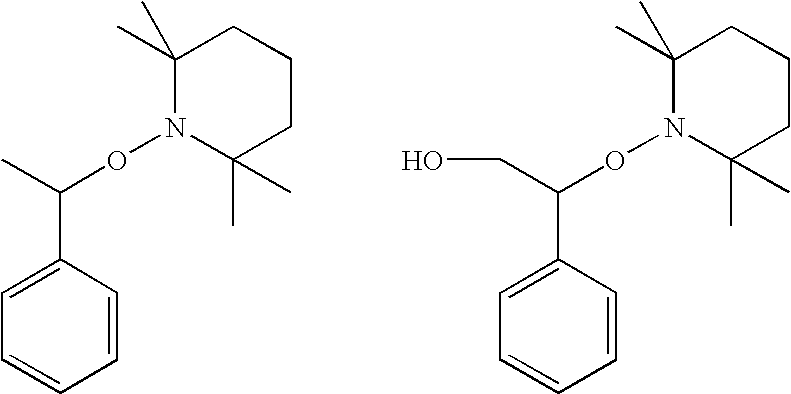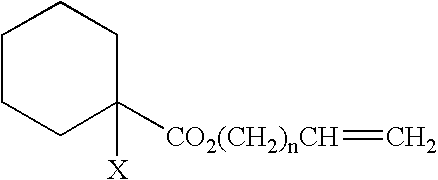Curing composition
a technology of composition and cure, applied in the field of cureable composition, can solve the problems of insufficient mechanical strength of the cured product, high polymerization rate, and rapid polymerization progress, and achieve the effects of excellent mechanical properties, precise control of molecular weight and functionalization ratio, and more appropriately controlled physical properties
- Summary
- Abstract
- Description
- Claims
- Application Information
AI Technical Summary
Benefits of technology
Problems solved by technology
Method used
Image
Examples
production example 1
Synthesis of acryloyl diterminal-poly(n-butyl acrylate / ethyl acrylate / 2-methoxyethyl acrylate)
[0167] Using cuprous bromide as the catalyst, pentamethyldiethylenetriamine as the ligand, diethyl-2,5-dibromoadipate as the initiator, n-butyl acrylate / ethyl acrylate / 2-methoxyethyl acrylate at a molar ratio of 25 / 46 / 29 was polymerized. Poly(n-butyl acrylate / ethyl acrylate / 2-methoxyethyl acrylate) with a terminal bromine group having a number average molecular weight of 16500 and a molecular weight distribution of 1.13 was obtained.
[0168] Four hundred grams of this polymer was dissolved in N,N-dimethylacetamide (400 mL), 10.7 g of potassium acrylate was added, and the mixture was stirred with heating at 70° C. for 6 hours under nitrogen atmosphere to obtain a mixture of poly(n-butyl acrylate / ethyl acrylate / 2-methoxyethyl acrylate) with an acroyl terminal group (hereinafter referred to as copolymer [P1]). N,N-dimethylacetamide in the mixture was distilled off under reduced pressure, tolue...
example 1
[0169] To 100 parts of copolymer [P1] obtained in Production Example 1, 10 parts of AEROSIL R974 (average size of primary particle 12 nm: available from NIPPON AEROSIL CO., LTD.) as a reinforcing silica, 0.2 parts of 2,2-diethoxyacetophenone (available from WAKO PURE CHEMICAL INDUSTRIES, LTD.) as a photopolymerization initiator, and 0.3 parts of SUMILIZER GS (2,4-di-t-amyl-6-[1-(3,5-di-t-amyl-2-hydroxyphenyl)ethyl]phenyl acrylate; available from SUMITOMO CHEMICAL CO., LTD.) as a monoacrylate phenolic antioxidant were combined, and the mixture was blended well using three paint rollers. The curable composition obtained as such was fully defoamed by an agitation defoaming apparatus, and then filled into a stainless steel mold, to obtain a thickness of about 2 mm. Ultraviolet irradiation was carried out with a high pressure mercury lamp so that the total amount of light would be 5000 mj / cm2 to obtain the cured product. The mechanical strength of the cured product obtained was as follow...
example 2
[0170] To 100 parts of copolymer [P1] obtained in Production Example 1, 10 parts of AEROSIL R974 (average size of primary particle 12 nm: available from NIPPON AEROSIL CO., LTD.) as a reinforcing silica, 0.2 parts of 2,2-diethoxyacetophenone (available from WAKO PURE CHEMICAL INDUSTRIES, LTD.) as a photopolymerization initiator, and 0.2 parts of SUMILIZER GS (2,4-di-t-amyl-6-[1-(3,5-di-t-amyl-2-hydroxyphenyl)ethyl]phenyl acrylate; available from SUMITOMO CHEMICAL CO., LTD.) as a monoacrylate phenolic antioxidant were combined, and the mixture was blended well using a three arm paint roller. The curable composition obtained as such was fully defoamed by an agitation defoaming apparatus, and then poured into a stainless metal mold, to obtain a thickness of about 2 mm. Ultraviolet irradiation was carried out with a high pressure mercury lamp so that the total amount of light would be 5000 mj / cm2 to obtain the cured product. The mechanical strength of the cured product obtained was as f...
PUM
| Property | Measurement | Unit |
|---|---|---|
| molecular weight distribution | aaaaa | aaaaa |
| mol % | aaaaa | aaaaa |
| mol % | aaaaa | aaaaa |
Abstract
Description
Claims
Application Information
 Login to View More
Login to View More - Generate Ideas
- Intellectual Property
- Life Sciences
- Materials
- Tech Scout
- Unparalleled Data Quality
- Higher Quality Content
- 60% Fewer Hallucinations
Browse by: Latest US Patents, China's latest patents, Technical Efficacy Thesaurus, Application Domain, Technology Topic, Popular Technical Reports.
© 2025 PatSnap. All rights reserved.Legal|Privacy policy|Modern Slavery Act Transparency Statement|Sitemap|About US| Contact US: help@patsnap.com



